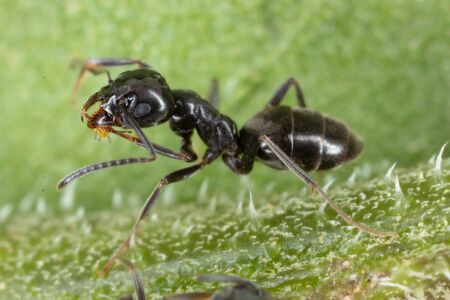
Good Natured: Odorous House Ant Part 2
With Illinois' General Primary just around the corner, I'm inclined to look at the feedback from last week's column in terms of election results.
If the early returns are any indication, odorous house ants are the frontrunners…of creatures most wanted OUT. Out of the kitchen, out of the bathroom, out of the house!
Although we've never polled people's opinions on other candidates for Most Unwelcome Guests, it seems that odorous house ants have some of the lowest approval ratings ever recorded. They've so far received a unanimous thumbs down from everyone who's taken the time to respond.
Even my friend Peggy, who goes out of her way to save nearly all forms of life (including jelly bean-sized opossum babies found in the pouch of their deceased momma), can't abide Tapioca, I mean Tapinoma sessile in her kitchen.
As she wrote, “…last year I noted that the ones that came in had a very distinct odor, even if you only squish one. Sorry but I did it. They have a very strong odor, enough that encouraging them to stay away by intense crumb- and counter-cleaning seemed better than smelling them. It may have been the guilt that came with the smell of death too."
Indeed, even the ant scientist credited with being the first to study the species in depth did so mainly because he saw it as a significant yet unrecognized house pest. In the 1928 paper where he coined the name “odorous house ant," Marion R. Smith called it the most important of all house infesting ants in Urbana, IL. He noted, “The ant was found in houses in nearly every block investigated, and in some blocks as high as 80 to 90 percent of the homes were infested."
Notice he used the “i" word: infested. Infestations are rarely considered a good thing.
Smith went on to describe the ants as “prying little busybodies, eternally poking their antennae into everything" and listed the foods the ants were known to—here it is again—infest: honey, sugar, preserves, pies, custards, marmalades, cooked and uncooked beef, fish, raw and fried liver, boiled and mashed potatoes, stewed prunes, cheese, milk, ice cream and ripe fruits.
What he didn't explain is how the ants gained access to this smorgasbord. I know in 1928 electric refrigeration was in its infancy, and ice boxes were the most common way to keep foods cool. (My Grandma Erickson, rest her soul, considered her fridge one of the greatest inventions of her time. She never did adopt the term refrigerator though, and called her treasured appliance “the ice box" for the rest of her days.) We even had one when I was a kid, although we used it as a cabinet for cookbooks and such. The doors had latches, but there was no gasket like we have in today's refrigerators.
My point—and I do have one—is that the pre-refrigeration era had to be the odorous house ants' glory days. Tolerant of a wide range of temperatures and small enough to slip through even tiny gaps, the industrious little creatures could forage at will. The world was their oyster. (I'll bet even oysters were their oyster…)
Today though, I can't think of a single home that doesn't have a refrigerator, and even older ones have pretty good gaskets. But still the ants persist.
When we wrapped up last week's column, I promised we would meet another ant scientist, and offer ways to control odorous house ants without using harsh chemicals or hiring an exterminator.
With that pledge in mind, allow me to introduce Eleanor Spicer Rice, PhD, an entomologist and prolific science writer with a particular interest in ants. In her book, Dr. Eleanor's Book of Common Ants of Chicago, she provides a plethora of helpful tips for keeping T. sessile at bay. I'll paraphrase them here:
- Use your detective skills to figure out how the ants are getting inside. Cut back branches touching the house and caulk cracks and crevices.
- If you have mulch around your foundation, consider switching it out for rocks, which provide less nesting habitat. Or switch to aromatic cedar mulch because, ironically, odorous house ants don't like the smell.
- Wipe up crumbs and drips. Make sure every last bit of food, even whatever goes in the garbage, is sealed up tight.
I'll add, at Casa Otto, I don't throw any food scraps in the kitchen trash. Anything vegetable based goes in the composter outside, and anything animal based goes in the freezer until pickup day. The cold temperatures, and secure gasket, keep these items safe from any “prying little busybodies" that might be in the vicinity. Sure I've got a few house ants, but their population is a fraction of what it was before I started these practices.
I get that it's probably only Dr. Eleanor and I who actually enjoy having these house guests around. (True story: I put a few grains of sugar on the kitchen floor and spent nearly an hour watching my little lodgers revel in this new bounty.) But before you blast them with Raid or call an exterminator, consider Dr. Eleanor's wise words:
“Much of what might be known about these ants hasn't been uncovered. Most of their tiny empire's treasures lay undiscovered."
Remember, mold gave us penicillin. Maybe odorous house ants are harboring a cure that's just waiting to be revealed. At my house anyway, I vote to let them stay.
Pam Otto is the outreach ambassador for the St. Charles Park District. She can be reached at potto@stcparks.org.

